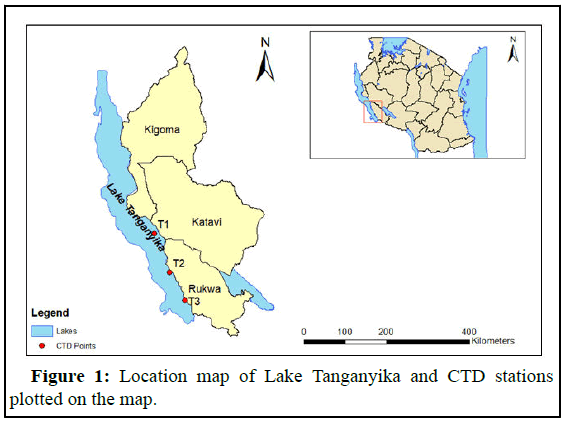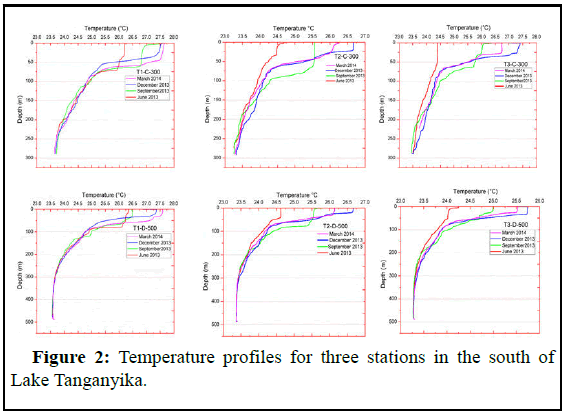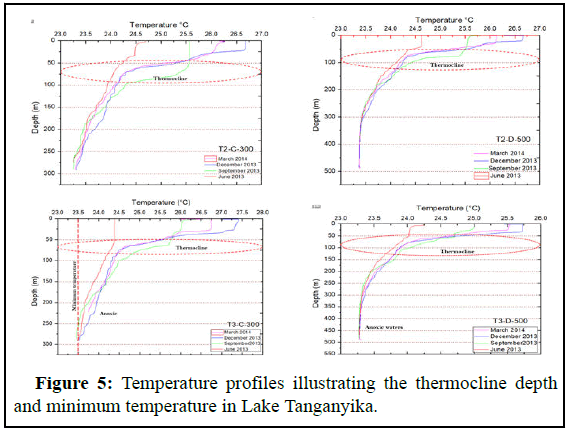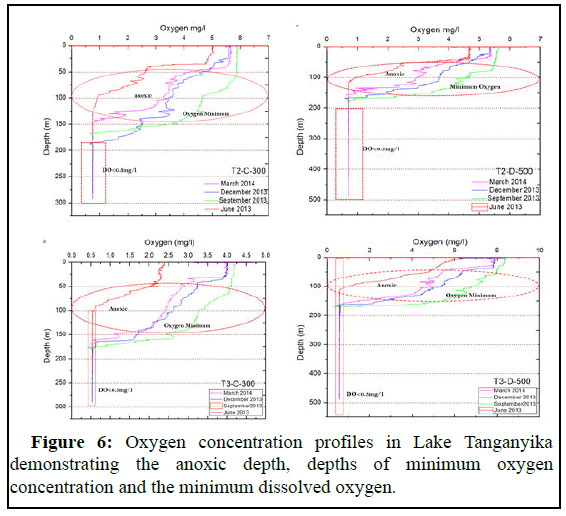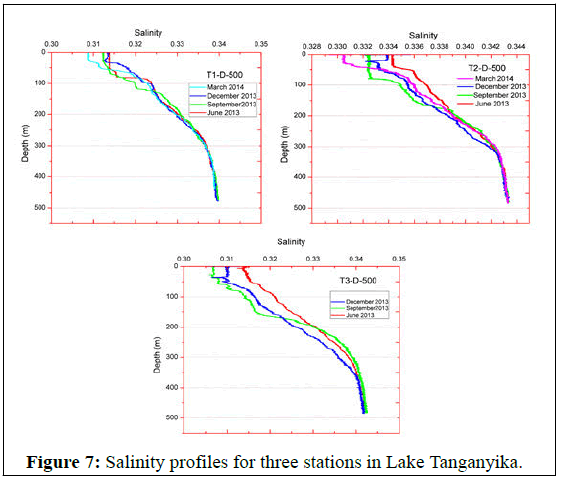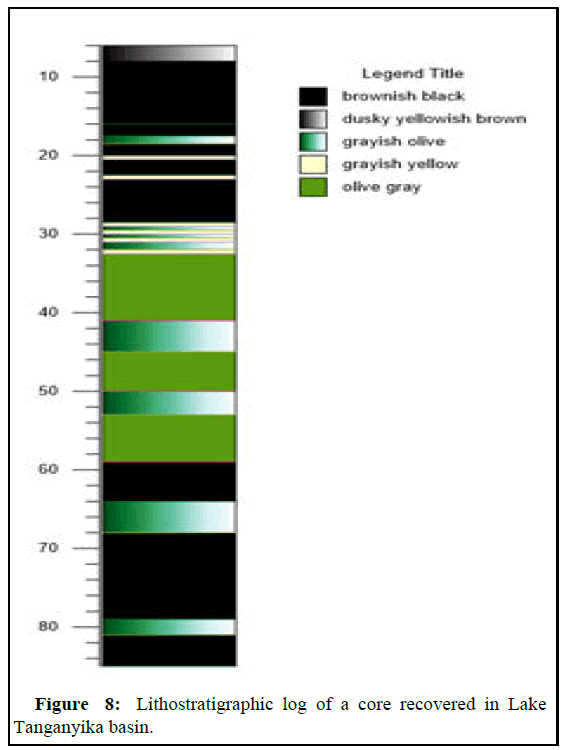Water Column Characteristics and Analysis of Conductivity, Temperature and Dissolved Oxygen (CTD) Data from Modern Rift Lake Tanganyika
Received: 16-Oct-2019 / Manuscript No. JESCC-23-3577 / Editor assigned: 21-Oct-2019 / PreQC No. JESCC-23-3577 / Reviewed: 04-Nov-2019 / QC No. JESCC-23-3577 / Revised: 03-Oct-2023 / Manuscript No. JESCC-23-3577 / Published Date: 31-Oct-2023
Abstract
Conductivity, temperature and dissolved oxygen profiles from modern Lake Tanganyika, a rift basin lake in East Africa, give an insight of the water column physical characteristics and implications for water quality and primary production. The profiles cover both arid and wet seasons for 2013/2014. Temperature and dissolved oxygen concentration of the water column decrease with depth from 29°C and over 80% (6.5 mg/l) saturation at the surface to 23.5°C below a thermocline. The lake permanently stratified between 50 m to 150 m, creating stable anoxic conditions. Specific conductance decreases from 688 µS cm-1 at surface to 677 µS cm-1 at 100 m of water column (thermocline) and gradually increase below the anoxic waters. Increase in salinity complements increase in water density that inhibits vertical mixing. Increase in dissolved organic matter attributed by increased anthropogenic activities, thus more terrestrial sediments transported into Lake Tanganyika by runoff rivers. Raised levels of dissolved organic matter have inhibited the growth of phytoplankton, limit photosynthesis, hence damaging ecosystem and impend primary productivity in the lake basin. As a result, anoxic bottom-water conditions substantially increase the preservation potential of organic-rich sediments because of the adverse effects on benthic scavenging and particle mixing and by supporting anaerobic processes. Climate variability has contributed to the regular changes in Lake Tanganyika water conditions and affect ecosystem.
Keywords: Lake Tanganyika, CTD data, Primary productivity, Lake anoxicity, Organic matter sediments
Keywords
Lake Tanganyika; CTD data; Primary productivity; Lake anoxicity; Organic matter sediments
Introduction
Integration of oceanographic and geochemical data has made it possible to comprehend many obscuring aspects of the genesis and primary productivity of high potential organic-rich sediments. Interest in the study of large lacustrine basins for hydrocarbon deposition, preservation, accumulation and paleoclimate has become more obvious in recent years. Fundamental to understanding these processes is studying the physical limnology. The physical limnology has implications on the basin and the organic-rich sediments in it. The most intriguing question to petroleum geologists has always been to understand the processes of oil and gas generation and destruction in sedimentary basins. Geochemical approaches employ different parameters to identify the hydrocarbon sources. However, the analysis usually narrows to a few rock samples retrieved from wells, to an entire sedimentary basin. High potential organic-rich sediments accumulation depends on the surface primary productivity and water quality and conditions. Modern tropical rift lakes of East Africa are good examples to understand the processes of hydrocarbon accumulations, paleoclimate studies and mineral deposits.
Understanding physical and biochemical limnology of Lake Tanganyika depends on conductivity, temperature, salinity, turbidity and dissolved oxygen data measured by an electronic recording CTD during 2013/2014. The goal is to review, analyse and understand the physical limnology of the lake (lacustrine) basin. In addition, to investigate some factors that can affect the primary productivity in Lake Tanganyika basin. Lake Tanganyika’s unique hydrography,variety of organisms, great modern geologic age and geographic setting offer an excellent opportunity to examine its water chemistry and a changing habitat in time and space. This rift lake and other African lakes are warming significantly rapid. As a result, warming has intensively increased the stratification of the water column, thereby trapping nutrients in deep water where they cannot support primary production and food cycle for bacteria. Concurrently, increased warming has enlarged the deprived-oxygen concentration zone [1].
Changing climates are rapidly altering lakes limnology and the inconsistent monitoring of lake physical and chemical parameters limit our understanding on the great effects of climate variability especially temperature and dissolved oxygen.
Materials and Methods
The oligotrophic Lake Tanganyika (Figure 1) is a lacustrine system, located in the west part of Tanzania between 3°S and 9°S latitude at an altitude of about 773 m above mean sea level MSL and the bordering mountain ranges may reach 2000 m. It is a young (9 Ma-12 Ma) halfgraben rift basin within the western arm of the Eastern Africa rift system. Along the rift system lakes, it is deepest (~1.47 km) and largest (18,900 km3) in terms of volume freshwater lake in the world after Lake Baikal in Siberia, south of Russia [1]. The lake extends NW-SE and runs from north direction near Lake Kivu to south near Lake Rukwa. Along the border-fault, catchments that enter Lake Tanganyika may exist fluvial and terrestrial material input channel flows. Rusizi river enters Lake Tanganyika in the north, draining water from salt Lake Kivu, while Malagarasi river drains fresh water into the lake. These two largest rivers influence density currents and surface temperature dispersal [2]. The Lake borders with the Democratic Republic of Congo (DRC) on the west and Zambia on its southern shore.
The lake comprises of three main basins namely Kigoma basin in the north, middle basin and Kipili basin in the south. Sills with depths of 655 m and 700 m respectively separate the middle basin from the north Kigoma and south Kipili basins. The middle Kipili basin forms the deepest part with a maximum depth of ~1472 m, followed by the north Kigoma basin that extends to the depth of ~1310 m.
Lake Tanganyika hydrography
Lake Tanganyika is the second largest fresh water lake in the world with a maximum length of 673 km and a maximum width of 72 km, covering a surface area of approximately 32,900 km2. The lake water is chemically mildly alkaline with a pH 9, in low salinity due to dilution by salt water entering from Lake Kivu through major inflow Rusizi River and other fresh water tributaries including Kalambo River and Malagarasi River, which is the second largest river in Tanzania [3]. Below depth of about 150 m, the lake waters and sediments are permanently in anoxic condition, meanwhile, the surface water (depth <50 m) is oxygenated (oxic) and suitable for aquatic living organisms. Therefore, the stratified waters in the lake is a good harbor for the formation of high-potential source rocks.
River inflows could raise the lake level by 0.5 m per annum and rainfall is roughly 0.8 m. Most of the total water influx (90%) is lost by evaporation while the remainder of the water is principally discharged by the outflow Lukuga River. Lake Tanganyika is oligotrophic/meromictic similar to other tropical lakes Malawi and Kivu. The lake can be divided vertically into three different layers. Stratified upper layer, dominated by seasonal mixing similar to other tropical lakes. This mixolimnion experience distinct seasonal temperature variability. The heating of the lake commences at the early wet season in late September to November [4]. The surface temperature varies from 23°C during summer to above 28°C in late December to early March (winter). An average temperature difference of 5°C is established between surface lake waters and the bottom layers casing a thermal stratification. The wet season (September to May) is characterized by weak winds over the lake surface waters, high humidity and significant precipitation, whereas the dry season (May to late August) is characterized by moderate precipitation and strong, regular southerly winds. A stable thermocline develops during warm season as deep as 50 m, below this depth; the lake is permanently stratified and anoxic. Previous study results from Lake Tanganyika have shown that stable stratification developed at 100 m and the division of water columns/layers (stratification) and rise of hypolimnetic waters are mainly due to wind-induced events such as upwelling and internal seiches [5]. Strong winds during the dry seasons cause the lake to loose heat through evaporation. Therefore, a stratification layer (thermocline) has uplifted with time due to climate variability.
Results and Discussion
The changes in temperature, conductivity, salinity and dissolved oxygen (CTD data) with water depth were phenomenal throughout the lake. Generally, temperature decreased with increasing water depth. In Figure 2, temperature decreased from above 28°C to below 23.5°C. Surface temperatures range from 24.3°C to 28°C, with the hottest temperatures on the southern flank of the lake in June during dry season. During wet season from October to April, the lake experienced high humidity and weak wind, with an average temperature of 26.5°C-27°C. During the dry season, May to September, the surface “cold” water temperature was 24.5°C [6]. The wind speed significance to cause upwelling is minimal. The significant difference from the typical profiles for dry and wet seasons is within the upper 100 m of the water column with thermocline at 50 m-100 m in the south.
Dissolved oxygen concentration generally decreased with depth from 6.5 mg L-1 (above 70% saturation) to anoxic conditions (Figure 3). A maximum concentration of 8.5 mg L-1 at 26.8°C observed above the lake water thermocline at station T2-C-300. Dissolved oxygen followed the same general trend as temperature, with the oxycline at 50 m in the south basin [6]. Therefore, transition from oxic to anoxic conditions was between 50 m to 150 m based on the temperature profiles.
The specific conductance of the water column in Lake Tanganyika habitually decreased from 688 μS cm-1 at the surface to below 677 μS cm-1 at depth around 100 m and gradually begin to increase at the lake bottom water (Figure 4). However, more than 45% gradual increase in conductivity with depth was between 100 m and 200 m and this transition occured substantially below the thermocline. Important differences exist between dry and wet seasons [7]. During dry season, June and September, conductivity ranged between 674 μS cm-1-681 μS cm-1, while during wet season, December and March, the readings ranged between 680 μS cm-1-688 μS cm-1.
Influence of temperature
Lake Tanganyika, a meromictic lake and permanently stratified below 100 m. However, some evidences indicate that mixing across the thermocline occurs along the south and north flanks, but steady and not enough to maintain the anoxic conditions in the monomolimnion. Nevertheless, the physical process is insignificant to allow mixing of surface with bottom portion of water column [8]. Along the deepest part of the lake (Kigoma basin), turbidity currents transport surface to near surface water to the Lake Bathymetry.
Significant decrease in temperature in Lake Tanganyika is from 50 m water depth and attain water stratification at 100 m. According to the temperature profiles (Figure 5), a thermocline established between 50 m depth to 150 m of water column. Recorded temperature readings when compared to previous studies several patterns of discrepancy emerge. The wind from the southern end blows over Lake Tanganyika during the dry season (May-September) [9]. This phenomenon has minor impact on the thermocline and causes insignificant upwelling in the south basin. The wind makes water in the southern basin less stratified and becomes colder during the night as is far from the equator.
Water temperatures cooler than 23.5°C, are observed for the lake’s surface especially the northern side where wind blows. The rise in bottom-water temperature in Lake Tanganyika received attention of different researchers and reported several times. The scenario attributed by heating from geothermal inputs from the earth core. However, water temperatures at the deep basin in this study are barely warmer than 23°C below 100 m.
Temperature differences in the mixolimnon of Lake Tanganyika can be explained by climatic variability (wind stress and solar heating) and geographic tropical location. Geothermal heat from the earth’s deep interior is presumed to warm the bottom waters in Lake Tanganyika but not necessary to influence the observed profiles. Deep-water temperatures smoothly increase by 0.1°C between 250 m-350 m [10].
In great tropical lakes, temperature is a great control factor on vertical stability (stratification) in the water column. Increase in specific conductance and decrease in temperature with depth along a water column yields increase in density. Therefore, increase in dissolved ions across the thermocline effects the density across the water column [11]. The fact that thermocline and stratification depth have increased in Lake Tanganyika, the anoxic layer is uplifted. This phenomenon hinders benthic faunal activities. Increased anoxic layer means primary productivity is affected; organic matter degradation and bioturbation in the lake slowed or significantly stopped.
Dissolved oxygen
Dissolved oxygen profiles show decrease in concentration with depth for upper water column. The oxycline and anoxic layer are in the same place. The decline in DO is consistent with an input of dissolved oxygen by advection and diffusion at the water surface, chemical oxidation reactions and diffusion at euphotic zone. Enlarged low-oxygen zone in Lake Tanganyika is attributed by increased warming (temperature), consequently inhibit lakes primary production and affect the ecosystem. Above 100 m, a turbid layer is interpreted as chemosynthetic bacteria, above anoxic conditions where aerobic synthetic of organic matter takes place [12]. Therefore, dissolved oxygen profiles (Figure 6) show a decreased DO concentration within the oxic to anoxic depth in Lake Tanganyika, and the DO values remain relatively constant below the anoxic water column (<0.5 mg/l at 100 m). This phenomenon of continuous decrease in DO is interrelated with previous observations.
Photo-inhibition affects oxygen production in top water column. The Lake Tanganyika water is highly transparent, radiations become so high at surface inhibiting primary production, forcing algae to move to deeper waters [13]. The decreased DO concentration has adverse effect on primary productivity and bacteria web.
Conductivity
Conductivity is higher at surface but tends to decrease until it reaches a thermocline (at 50 m-100 m) below, which it gradually starts to increase again. Generally, specific conductance increases with depth more than 50% of high specific conductance occurs across the upper water boundary. Conductivity tends to decrease where photic organisms are present because they take up ions. The conductivity peak in the lake water column is at the same location as the thermocline. Planktons dwelling in the epilimnion decrease the conductivity and bacteria and other organisms decrease the conductivity just below or above and/or right at the thermocline. Saunders and Fofonoff earlier observation on conductivity and lake chemistry data indicated that, the conductance to salinity conversion underestimates the salinity predicted by the total mass of dissolved ions in 1 kg of lake water. However, the percentage increase in salinity between surface and bottom waters of the lake shown in the salinity profiles resembles to predicted salinity by the distribution of major chemical dissolved ions with depth. Decreased temperature and increased salinity with depth affect lake water density [14]. That is, biological nutrients or reduced ions control the water conductivity in smaller extent compared to major ions. The changes in specific conductance are consistent with actual increase in evaporation relative to precipitation within Lake Tanganyika (Figure 7).
The water density gradient controls the degree of vertical mixing across the chemocline. Salinity defines the density structure across the chemocline during the wet, warm season and may be the only obstruction to vertical mixing across the chemocline during the cool season. However, evidences suggest that the chemocline is not a permanent barrier to vertical mixing.
Lake Tanganyika’s alkalinity increases with its age. Lake’s alkalinity increases with depth because carbon ions accumulate in deep waters, where autotrophs cannot assimilate. The southern basin of Lake Tanganyika has higher alkalinity at surface and in deep waters probably associated by different watershed inputs. An assumption that nutrient rich deep water influence primary production when brought near surface during dry season. Consumption of near surface carbonates during photosynthesis results in elevated pH values.
Lake mixing along Lake Tanganyika southern basin is minimal or relatively insignificant across the chemocline, forming permanent thermocline. During dry season, south winds blow warm epilimnion waters towards the north, resulting in the tilt of epilimnion. Thermocline adjusts depending on volume of warm water driven and is an indicator of the strength of the wind. Insignificant upwelling was inferred from measurements of cooler water that averaged 24.5°C at the surface during dry season. By the end of dry season (September), the lake retained its stable thermocline and south winds ceased and metalimnion retreated to its original horizontal plane.
Fluorescence Dissolved Organic Matter (FDOM)
One of the main pools of carbon in lacustrine basins is Dissolved Organic Matter (DOM), containing both autochthonous (algae/ diatoms) and allochthonous (terrestrial) sources. Chromophoric Dissolved Organic Matter (CDOM) is a naturally occurring dissolved matter that absorbs UV light in water. Human activities (cultivation and deforestation) have a significant effect in Lake Tanganyika waters by increasing the amount of dissolved organic matter. Raised levels of FDOM have inhibited the growth of phytoplankton, limit photosynthesis, hence damaging ecosystem and impend primary productivity in the lake basin. Climate changes (increased warming and precipitation) influence the amount of terrestrial organic matter (CDOM is river-derived) transported into the lake and lower salinity.
Physical limnology and primary production
Organic matter accumulation in lacustrine basins depends fundamentally on the preservation conditions and surface water primary productivity. Uplifted thermocline and chemocline in Lake Tanganyika have greatly affected primary production. Similarly, increased river runoff has led to increased terrestrial organic matter inputs but lowered salinity. This scenario has resulted into brownification of natural shallow marginal lake water. Continuous input of terrestrial sediments has negatively affected the water column, with less light penetrating the water layer (epilimnion). Consequently, the amount of light energy reaching the photic phytoplankton is reduced hence primary production lowered. The anticipation is deposition of more allochthonous sediments than autochthonous sediments in marginal basins of modern Lake Tanganyika.
Higher organic content, TOC>5% for sediments in the littoral zones and deep basins of Lake Tanganyika is an evidence that the organic sediments subjected in favorable preservation condition forming crumbly black clay formations/successions of homogeneous black shale/clays and very fine laminated dark green and beige millimeterthick laminae (Figure 8). The process enhanced by elevated thermocline/stratification and continuously decrease in oxygen concentration in the water column as shown in the DO profiles. Rift axis margins TOC values suffer dilution by terrestrial sediments. Prevailing of reducing conditions throughout a large water column in rift Lake Tanganyika hamper organic matter degradation. However, the amount of organic matter preserved would depend on the extent of organic matter degradation in the anoxic condition (Table 1).
| No | Sample location | Basin structure | TOC values (wt %) |
|---|---|---|---|
| 1 | Nyanza | Accommodation zone | 0.36-4.76 |
| 2 | Rusizi | Rift axis | 0.18-1.91 |
| 3 | Cape Banza | Accommodation zone | 1.0-5.5 |
| 4 | Bemba | Escarpment margin | 0.73-3.25 |
| 5 | Magara | Accommodation zone | 0.5-4.76 |
Table 1: Examples of sample locations and basin structures with their appropriate TOC values.
Conclusion
CTD profiles highlight physical processes and characteristics of water column in the rift basin. Profiles of temperature, dissolved oxygen and conductivity are consistent with other previous observations. Temperature decreases with depth as well as the dissolved oxygen. Specific conductance of water column increases with depth with more than 50% increase below thermocline (150 m).
Previous and current observational lake-temperature data suggest that Lake Tanganyika has warmed greatly in response to global climate change, leading to an increase in stratification and eventually reduction in primary productivity. On the other hand, oxygen concentration and demand relate to surface biological productivity. The amount of organic matter in sediments below anoxic waters is often more abundant and lipid-rich than those under oxic water because of the absence of benthonic scavenging. Evidences from ancient lacustrine oil basins suggest that ancient organic rich sediments containing hydrogen-rich kerogens deposited in similar anoxic environment. This is therefore analogous to modern Lake Tanganyika sediments deposited under same anoxic environment. Lake water properties influence the depositional materials and environment. Therefore, the lake water experiences early and shallow depth anoxicity, a good environment for OM preservation. For the modern sediments, the degradation of OM is slower in the absence of oxygen. However, anoxic conditions result in enhanced OM preservation over geological time and absence of oxygen affect the degradation of OM in modern and ancient sediments.
Recent observations have improved understanding of limnology of Lake Tanganyika despite many questions remain unsolved. Continuous observations would be required to unlock ambiguities and better understand the limnology of Lake Tanganyika in relation to environment and climate.
• From the temperature profiles, Lake Tanganyika permanently
stratified at depth between 50 m to 150 m creating stable anoxic
conditions. Lake Tanganyika suffers little effect by upwelling
(seasonal winds). This is due to deep-water depth, anthropogenic
activities etc and sediments rich in organic matter deposit in the
deep anoxic environment.
• Dissolved oxygen DO concentration decreases with depth.
Maximum concentrations are at surfaces to above a lake
thermocline, below which concentrations are adverse and inhibit
aerobic reactions by scavenging bacteria.
• Primary productivity is fundamentally affected by water quality and
physical limnological factors such as reduced DO concentration,
salinity and uplifted water column stratification (thermocline).
• Sediments deposited below anoxic waters (100 m and dissolved
oxygen less than 0.5 mg/l) contain abundant organic matter and rich
in lipids, a phenomenon coupled by low-oxygen zone and lack of
bioturbation. This means the anaerobic residues are significantly the
precursor to oil-prone kerogens.
• Conductivity increases with lake water depth. Conductance has a
direct relation with salinity, which increases with depth as well in
Lake Tanganyika, affecting the water density and chemistry. An
early increase in conductance below water surface is an indication
that the lake is stratified at shallow depth (from 50 m to 150 m)
forming anoxic environment.
• In Lake Tanganyika, the littoral and lake margin sediments have low
TOC (<1) content because of rapid degradation of reactive organic
matter deposited in these sediments. These sandy sediments have
high permeability, leading to far greater sediment oxygen
penetration than observed in more fine-grained, muddy deep
sediments. So prolonged oxygen exposure may enhance organic
matter OM remineralization and eventually minimize organic matter
OM preservation. Contrary deep-basin sediments constitute high
organic content (TOC>5) because of limited oxygen supply and
enhanced OM preservation.
Acknowledgement
This project benefited from the grant of China national key scientific project (2016ZX05006-007) awarded to China University of Petroleum (UPC). Furthermore, I gratefully acknowledge the support from the Tanzania Petroleum Development Co-operation (TPDC) for providing datasets.
References
- Rudd JW (1980) Methane oxidation in Lake Tanganyika (East Africa). Limnol Oceanogr 25: 958-963.
- Hecky RE, Bugenyi FW (1992) Hydrology and chemistry of the African great lakes and water quality issues: Problems and solutions. Intern Assoc Theor Appl Limnol Commun 23: 45-54.
- Cohen AS, Palacios-Fest MR, Msaky ES, Alin SR, McKee B, et al. (2005) Paleolimnological investigations of anthropogenic environmental change in Lake Tanganyika: IX. Summary of paleorecords of environmental change and catchment deforestation at Lake Tanganyika and impacts on the Lake Tanganyika ecosystem. J Paleolimnol 34: 125-145.
- Rosendahl BR, Reynolds DJ, Lorber PM, Burgess CF, McGill J, et al. (1986) Structural expressions of rifting: Lessons from Lake Tanganyika, Africa. Geol Soc London Spec Pub 25: 29-43.
- Demaison GJ, Moore GT (1980) Anoxic environments and oil source bed genesis. Organic Geochem 2: 9-31.
- O’Reilly CM, Dettman DL, Cohen AS (2005) Paleolimnological investigations of anthropogenic environmental change in Lake Tanganyika: VI. Geochemical indicators. J Paleolimnol 34: 85-91.
- Degens ET, von Herzen RP, Wong HK (1971) Lake Tanganyika: Water chemistry, sediments, geological structure. Natur 58: 229-241.
- Teale EO, Harvey E (1933) A physiographical map of Tanganyika territory. Geogr Rev 23: 402-413.
- Halfman JD (1993) Water column characteristics from modern CTD data, Lake Malawi, Africa. J Great Lakes Res 19: 512-520.
- Kimirei IA, Mgaya YD (2007) Influence of environmental factors on seasonal changes in clupeid catches in the Kigoma area of Lake Tanganyika. Afr J Aquat Sci 32: 291-298.
- Phiri H, Shirakihara K. (1999) Distribution and seasonal movement of pelagic fish in southern Lake Tanganyika. Fish Res. 41:63-71.
- Kotilainen AT, Shackleton NJ (1995) Rapid climate variability in the north pacific ocean during the past 95,000 years. Nature 377: 323-326.
- Langenberg VT, Mwape LM, Tshibangu K, Tumba JM, Koelmans AA, et al. (2002) Comparison of thermal stratification, light attenuation and chlorophyll-a dynamics between the ends of Lake Tanganyika. Aqua Ecosyst Health Manag 5: 255-265.
- Drerup SA, Vadeboncoeur Y (2016) Elevated specific conductance enhances productivity and biomass of periphytic cyanobacteria from Lake Tahoe and Lake Tanganyika. Phycol 55: 295-298.
Select your language of interest to view the total content in your interested language
Share This Article
Recommended Journals
Open Access Journals
Article Usage
- Total views: 1772
- [From(publication date): 0-2023 - Nov 21, 2025]
- Breakdown by view type
- HTML page views: 1435
- PDF downloads: 337

